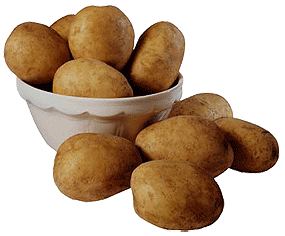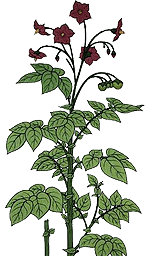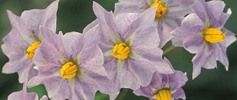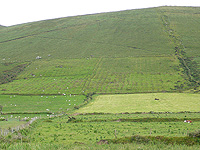



Custom Search
|
|
"People will not look forward to posterity who never look backward to their ancestors." Quotes Shops Ireland Bunús na Gaeilge Did You Know? Himself/Herself Write to Us Readers Write.. Links/Link to Us Advertise with us
Help keep us free |
 The Year of the Spud The Year of the SpudBy Mattie Lennon “She was one of those downright, upright, Northern breed which loved a good floury potato and a good flowery sermon” (W. R.Rogers) Along with Jack Charleton, Charlie Lansborough, divorce and lap-dancing we have taken the potato to our heart and claimed it as our own even though China and India harvest almost a third of today’s supply. You wouldn’t be likely to hear a Wicklow farmer asking a neighbour, “Have you completed the harvesting of your Solanum Tuberosum”? He would of course say, “Have ye them (the spuds) all dug”? which is the same thing. The humble spud ranks among the world's fourth most important food crop, after maize, wheat and rice. The potato belongs to the Solanaceae - or "nightshade"- family of flowering plants, and shares the genus Solanum with at least 1,000 other species, including tomato and eggplant. Solanum Tuberosum is divided into two, only slightly different, subspecies: andigena, which is adapted to short day conditions and is mainly grown in the Andes, and Tuberosum, the potato now cultivated around the world, which is believed to be descended from a small introduction to Europe of andigena potatoes that later adapted to longer day lengths. The United Nations has declared 2008 the International Year of the Potato, to increase awareness (an official aim is to achieve an “enhanced profile of the potato”). The idea was suggested by Peru, the home of the potato and of the International Potato Centre, a locus of cutting-edge potato research.  Brought to Europe by the Spanish, potatoes were first eaten reluctantly—Europeans had no idea which parts of the plant were poisonous. But over time they became a dietary staple (tragically so in Ireland, where the failed potato crop between 1845 and 1849 dramatically reduced the population through starvation, disease and mass emigration). Now Europeans each consume about 93kg a year. Production, like consumption, has gone global. Brought to Europe by the Spanish, potatoes were first eaten reluctantly—Europeans had no idea which parts of the plant were poisonous. But over time they became a dietary staple (tragically so in Ireland, where the failed potato crop between 1845 and 1849 dramatically reduced the population through starvation, disease and mass emigration). Now Europeans each consume about 93kg a year. Production, like consumption, has gone global.But has it been absorbed into the literature culture and folklore of any country to the same extent as it has in Ireland. As far as I can ascertain you wouldn’t hear a singer, in Lima, regaling the company with an account of how he “met her in the garden where the praties grow”. Liam O’Flaherty wrote a novel, Famine, and in later years Tom Murphy’s drama of the same name painted a vivid picture of the same era. Cecil Woodham Smith’s “Great Hunger” is a factual account backed up by frightening statistics. Kavanagh was moved on many occasions by the humble spud. In “The Great Hunger” he writes of, ”Where the potato-gatherers like mechanized scarecrows move” and in “Spraying The Potatoes” he immortalizes a neighbour’s simple salutation in the field; He turned my way. 'God further the work'. He echoed an ancient farming prayer. I thanked him. He eyed the potato drills. He said: 'You are bound to have good ones there'. Parallel ridges which the elements have failed to erase in a hundred and sixty years bear testimony to this day to potatoes which were planted but never dug. This reminder has inspired many a songwriter and poet. Dan Keanes moving and tragic ballad “Famine Years” is a work of art and more recently my old friend John McGrath penned; Hungry land Your people deserved better Summer never wetter Turf-sods floating in the bog-hole Praties sick and dying Like the people that sad winter Heart of flint, you sent Another sorry summer, Scorned their plight. The blight. In every furrow sealed their fate No hope and no tomorrow. Yellow meal, too little and too late. In a country that suffered much through its failure it’s not surprising that the potato features in its Prayers. The first line of the “Kerry Blessing” is, “That the frost may never afflict your spuds . . .” Yes, the potato provided cultural as well as physical food for our forefathers and even its failure had a marked effect on world affairs. The great famine accentuated the “brain-drain” long before the term was coined. The exodus was to provide Presidents, missionaries, writers and tycoons to foreign lands. And (God between us and all harm) the descendants of some of those who fled from hunger went on to become gangsters in places as far apart as Tammany Hall and the Australian outback.  While few Murphys would object to the sobriquet “Spud” George Hook was underwhelmed a few months ago when a when he thought that a Michael-extracter, on television, had called him “potato head “ in Spanish. While few Murphys would object to the sobriquet “Spud” George Hook was underwhelmed a few months ago when a when he thought that a Michael-extracter, on television, had called him “potato head “ in Spanish.In the area of metaphor and simile the humble spud has held its own. In the Kylebeg and Lacken of my youth it would often be said of a person who, contrary to popular opinion, considered themselves smart, “Sure, he knows nothing o’ny when they’re done ate them”. An uncle of mine who seemed to be in somewhat of a time-warp as far as the agricultural calendar was concerned once sowed potatoes on the ninth of June but normally if you didn’t have your drills covered before “Punchestown” (The races of Punchestown in the last week of April) your farming prowess would be in serious doubt.  “Cutting seed” (the practice of slicing a single tabor to make several seed) was a skill, although overestimated by some. A ploughman who could open a drill “as straight as the barrel of a gun” was a prized member of staff for any strong farmer. Next came “moulding” or “brushing” the drills. This involved putting extra clay to the growing stalks with the plough. And later in the summer the Radio Eireann weather forecast would, at times, include a “blight-warning”. “Cutting seed” (the practice of slicing a single tabor to make several seed) was a skill, although overestimated by some. A ploughman who could open a drill “as straight as the barrel of a gun” was a prized member of staff for any strong farmer. Next came “moulding” or “brushing” the drills. This involved putting extra clay to the growing stalks with the plough. And later in the summer the Radio Eireann weather forecast would, at times, include a “blight-warning”.Though the spud was the staple diet of many families young males were, at times, especially at weekends, inclined to abstain on the grounds that their chances in the local dancehalls would be greatly increased if flatulence could be kept to a minimum.  Last March, food scientists met in Cusco, Peru to find ways of boosting world potato production. Most of the nutrients which we require are contained in the potato. These include Protein, Fibre, Phosphrous, Vitamins A, B1 and B2, Magnesium, Potassium, Carbohydrate, Calcium, Iron, Niacin and Sodium. And your potato has only 1% fat. Yet we in Ireland can still be made to feel inferior because of our fondness for the spud. When begrudgers describe us as “potato eaters” some of us can feel hurt. Isn’t it amazing that buying slivers of a Golden Wonder, saturated in grease, in a provincial town at midnight from a native of Turin is considered not only acceptable but hip while the consumption of the wholesome “spuds an’ butter” is looked upon as the height of peasant vulgarity? Last March, food scientists met in Cusco, Peru to find ways of boosting world potato production. Most of the nutrients which we require are contained in the potato. These include Protein, Fibre, Phosphrous, Vitamins A, B1 and B2, Magnesium, Potassium, Carbohydrate, Calcium, Iron, Niacin and Sodium. And your potato has only 1% fat. Yet we in Ireland can still be made to feel inferior because of our fondness for the spud. When begrudgers describe us as “potato eaters” some of us can feel hurt. Isn’t it amazing that buying slivers of a Golden Wonder, saturated in grease, in a provincial town at midnight from a native of Turin is considered not only acceptable but hip while the consumption of the wholesome “spuds an’ butter” is looked upon as the height of peasant vulgarity?And before I go, here’s a little I.Q. test for you; Which of the following is the odd-one-out; potato, knife, cabbage? No. You’re wrong. The answer is cabbage; you can make chips with the other two. Photo Credits: The Year of the Potato How Stuff Works The Irish Potato For more on the potato, please click A Taste of Ireland: The potato. And for our many recipes click Potato. |
The New Irish Table Margaret Johnson’s love of Ireland permeates page after glorious page of mouthwatering Irish dishes, from Smoked Salmon Chowder to Raspberry Buttermilk Tarts. Lavish color photographs of the food, the landscapes, and the people are woven through the text, making The New Irish Table the next best thing to sitting down to dinner in Ireland itself.
|
||||||||||||||
|
|
||||||||||||||||
| All contents copyright © 2001 through 2011 inclusive - all rights reserved. March 4, 2011 |
|
|
||||||||||||||